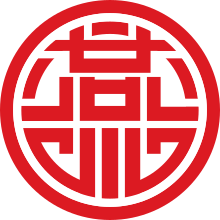Yenching University
燕京大學 | |
 | |
| Motto | 因真理 得自由 以服務 |
|---|---|
Motto in English | Freedom Through Truth For Service |
| Active | 1919–1952 |
| Location | |
| Yenching University | |||||||||||||
|---|---|---|---|---|---|---|---|---|---|---|---|---|---|
| Traditional Chinese | 燕京大學 | ||||||||||||
| |||||||||||||
Template:Contains Chinese text

Yenching University (Chinese: 燕京大學; pinyin: Yānjīng Dàxué), was a university in Beijing, China, that was formed out of the merger of four Christian colleges between the years 1915 and 1920.[1] The term "Yenching" comes from an alternative name of old Beijing derived from its status as capital of Yan state, one of the seven Warring States that existed until the 3rd century BC.
History
Yenching University was formed through the merger of four Christian schools over the course of five years, from 1915 to 1920:[1]
- Huiwen University (Chinese: 滙文大學; pinyin: Huìwén Dàxué), also known as the Methodist Peking University founded in 1890 by the Methodist Episcopal Church. This should not be confused with the National Peking University founded eight years later in 1898. Huiwen's precursor (崇內懷理書院) was founded in 1870. Hiram Harrison Lowry was its principal.
- North China Union College in Tongzhou (Chinese: 通州協和大學; pinyin: Tōngzhōu Xiéhé Dàxué). Its precursor (公理會潞河書院) was founded by the Congregational Church. Devello Z. Sheffield was the school's principal.
- North China Union College for Women (Chinese: 華北協和女子大學; pinyin: Huáběi Xiéhé Nǚzǐ Dàxué). Its precursor, Bridgman Academy (Chinese: 貝滿女塾; pinyin: Bèimǎn Nǚ Shú), was founded in 1864 Eliza J. Bridgman. It would be renamed the North China Union College for Women in 1907, with Luella Miner as its first president, and join Yenching University in 1920.
- The school of theology was itself a union of the theological seminary of North China Education Union and two Methodist theological schools in Beijing.
John Leighton Stuart was appointed as the principal of the university in January 1919 when he taught Greek in Nanking Theological Seminary (金陵神學院), a seminary in Nanjing. Being short of capital at the beginning, he turned to fundraising worldwide and received support from the estate of Charles Martin Hall, an American executive of Alcoa Aluminum. The university bought the royal gardens of a Qing Dynasty prince to build a scenic campus and employed gardeners from the Imperial gardens. In 1926 the campus was completed. Theology, Law and Medical were the main schools in the university, with Arts and Science studies.
Stuart determined to create a university that served the Chinese nation. He attracted major Chinese and Western scholars to teach. Religion was not a qualification, although Stuart gave major support to the School of Theology. Among the first was William Hung, who became Chairman of the History Department and Dean. In 1928 the Harvard-Yenching Institute, was jointly founded by Yenching University and Harvard University for the teaching of the humanities and social sciences in East Asia. Under Hung, the university's reputation for Chinese studies steadily rose, especially with the publication of the Harvard-Yenching Sinological Index Series. By 1930, the school was among the top universities in China, its teaching distinguished itself by a considerable academic freedom.
During the Second Sino-Japanese War, the area was occupied by Japan and the university was moved to Chengdu in Sichuan. After the People's Republic of China was established in 1949, Yenching University remained open, although under control of the Chinese Communist Party. In 1952, after the entry of China into the Korean War, its arts and science faculty were shifted into Peking University and other institutions, its politics and law faculty were shifted into China University of Political Science and Law, its economics faculty were shifted into Central University of Finance and Economics, its sociology faculty were shifted into Minzu University of China, and other faculty shifted into other institutions. At the same time, its engineering section was merged with Tsinghua University, and Peking University obtained the former Yenching campus. In 1952 Peking University moved from central downtown Beijing to the previous Yenching campus in the city's Haidian District.
Scholars
Among the scholars who taught at Yenching University were:
- Zhang Dongsun (Philosopher)
- K. C. Hsiao (political scientist)
- John Stuart Burgess (sociologist)
- Kenneth K.S. Chen (historian of Buddhism)
- Wu Wenzao (sociologist)
- Zhao Zichen (theology)
- William Hung (sinologist)
- Lu Zhiwei (theologian)
- Wu Leichuan (theology)
- Qian Mu (historian)
- Edgar Snow (journalism)
- Louis Rhys Oxley Bevan (Law)
Alumni
Prominent alumni include:
- Fei Xiaotong (anthropologist)
- Han Suyin (author)
- C.K. Yang (anthropologist)
- Bing Xin (Xie Wanying) writer
- Teng Ssu-yu (historian)
- Gong Peng (diplomat)
- Huang Hua (diplomat)
- James Shen (diplomat)
See also
- History of Beijing
- Michael Lindsay, 2nd Baron Lindsay of Birker and Hsiao Li Lindsay, Baroness Lindsay of Birker
Notes
- ^ a b West, Philip (1976). Yenching University and Sino-Western Relations, 1916-1952. Cambridge, MA: Harvard University Press. pp. 34–39. ISBN 9780674965690.
References
- West, Phillip Yenching University and Sino-Western Relations, 1916-1952 (Cambridge: Harvard University Press, 1976).
- Arthur Lewis Rosenbaum. ed., New Perspectives on Yenching University, 1916-1952 : A Liberal Education for a New China. (Chicago: Imprint Publications, 2012). ISBN 1879176483. Some of the essays were first published in Journal of American-East Asian Relations 14: 1-4 (2004-2006).
External links
- Internet Mission Photography Archive (enter "Yenching University in Search Box)
- Photos at the International Mission Photography Archive
